The fisheries sector is composed of four subsectors, namely, commercial, marine municipal, inland municipal, and aquaculture. There are four quarterly surveys that generate the volume and value of production by species at the national, regional, and provincial level. The statistics primarily serve as input to the compilation of performance of agriculture and national accounts. The data sets are also used for policy making and program implementation towards the development of the fisheries sector.
A. Volume of Fisheries Production
The volume of fisheries production in Davao Region during the first quarter of 2025 reached 16,126.40 metric tons. This is an increase of 17.8 percent from the 13,694 .99 metric tons recorded in the same period of 2024 (Table 1).
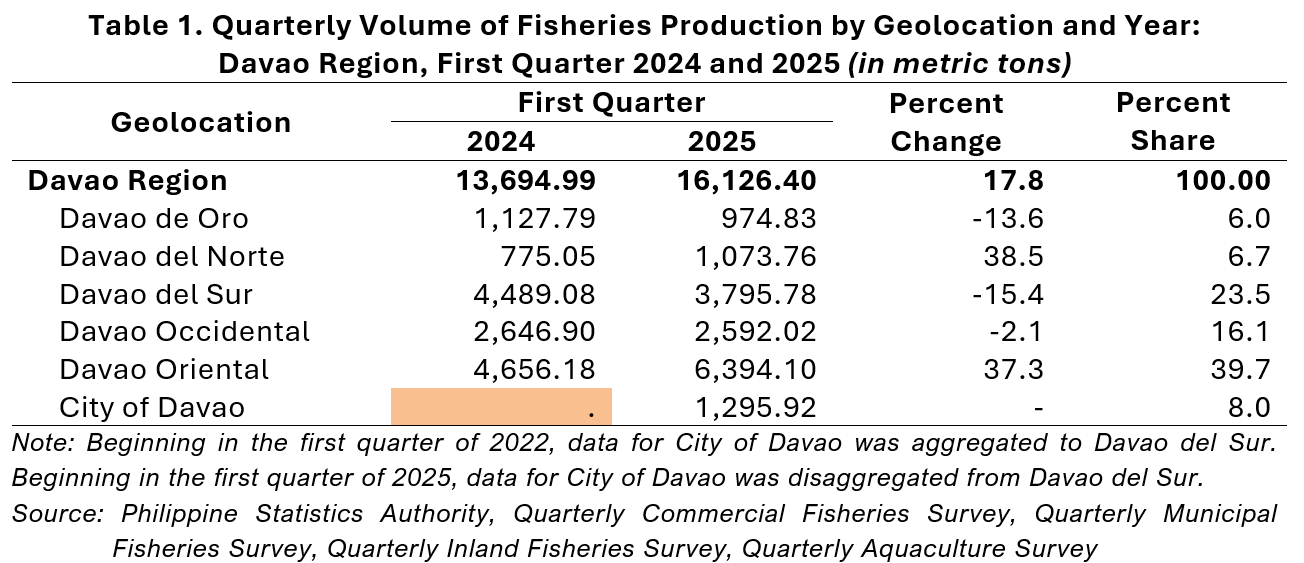
Among the provinces and highly urbanized city (HUC), Davao Oriental recorded one of the most notable increases, with production jumping by 37.3 percent from 4,656.18 to 6,394.10 metric tons. Similarly, Davao del Norte saw a substantial increase of 38.5 percent, from 775.05 to 1,073.76 metric tons. Conversely, several provinces experienced a decline. Davao del Sur’s production dropped sharply by 15.4 percent, from 4,489.08 to 3,795.78 metric tons, while Davao de Oro declined by 13.6 percent and Davao Occidental by 2.1 percent. Davao City had a production of 1,295.92 metric tons.
In terms of share to the total regional production during the quarter, Davao Oriental emerged as the leading contributor, producing 6,394.10 metric tons, which accounted for 39.6 percent of the regional total. Davao del Sur followed as the second-highest contributor, with a production of 3,795.78 metric tons, representing 23.5 percent of the total. The City of Davao, on the other hand, produced 1,295.92 metric tons, comprising 8.0 percent of the region’s output. Davao Occidental ranked next with 2,592.02 metric tons, contributing 16.1 percent, while Davao del Norte produced 1,073.76 metric tons, accounting for 6.7 percent. Lastly, Davao de Oro had the smallest share, with 974.83 metric tons, or 6.0 percent of the regional total.
B. Volume of Commercial Fisheries Production
Commercial fisheries cover fishing operations in marine waters beyond 15 kilometers from the shoreline by fishing boats with more than three gross tons.
In the first quarter of 2025, Davao Region recorded a total commercial fisheries production of 2,321.56 metric tons, showing a remarkable increase of 102.0% compared to the 1,149.34 metric tons produced in the same period of 2024. This substantial growth highlights a significant boost in the region’s commercial fishing activities over the one-year period.
Breaking down the production by province and HUC, Davao Oriental posted the highest output with 1,961.00 metric tons, representing a 92.0 percent increase from its 2024 level of 1,021.13 metric tons. Davao Occidental also showed an increase, although more modest, with production rising by 17.1 percent, from 50.28 to 58.87 metric tons. In contrast, Davao del Sur experienced a sharp decline of 73.2 percent, with production dropping from 77.93 to 20.90 metric tons. The City of Davao recorded 280.78 metric tons production during the period (Table 2).
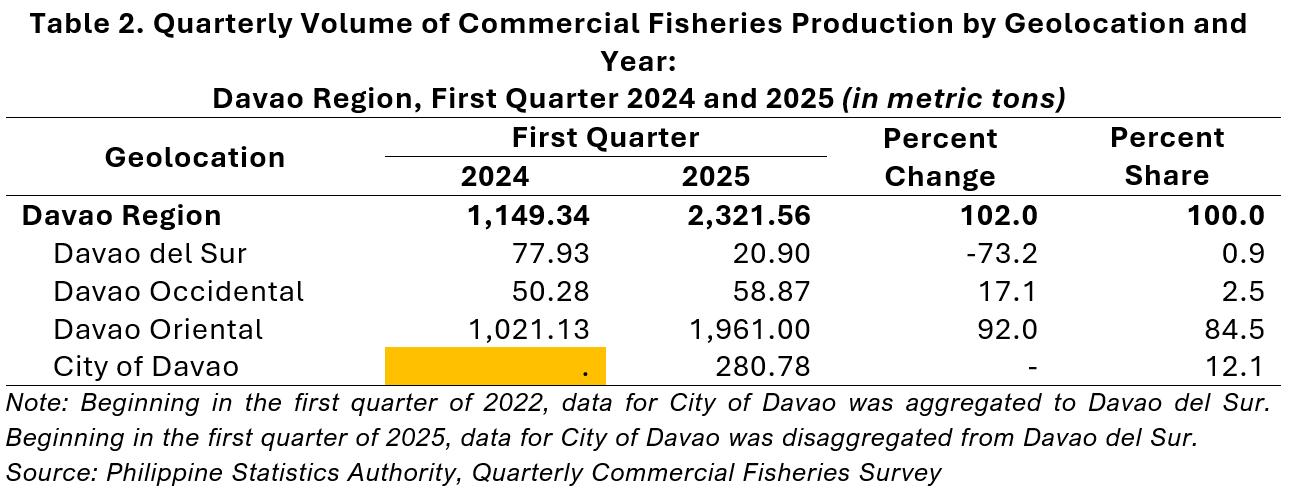
In terms of contribution to the region’s total production in 2025, Davao Oriental dominated with a substantial 84.5 percent share. The City of Davao emerged as the second-largest contributor, accounting for 12.1 percent of the total. Davao Occidental followed with a modest 2.5 percent share, while Davao del Sur contributed a minimal 0.9 percent. This distribution reveals a strong concentration of commercial fisheries activity in Davao Oriental and the City of Davao, which together made up over 96.0 percent of the total regional output.
C. Volume of Marine Municipal Fisheries Production
Municipal fisheries cover fishing operations in marine waters within 15 kilometers from the shoreline, either without the use of a fishing boat or with the use of fishing boat with three gross tons or less.
The region recorded a total marine municipal fisheries production of 7,646.23 metric tons, showing a slight decrease of 0.2 percent from the 7,662.16 metric tons produced in the same period of 2024. This marginal decline suggests relative stability in marine municipal fisheries production across the region despite varied performances among the provinces and HUC.
Across the region, Davao Oriental had the highest production at 4,073.33 metric tons, reflecting a 14.6 percent increase from 3,552.98 metric tons in the first quarter of 2024. Davao del Norte also experienced an increase of 5.9 percent from 375.01 to 397.09 metric tons. Meanwhile, other provinces saw declines: Davao de Oro posted the most significant drop of 59.9 percent, from 652.91 to 261.87 metric tons. Davao del Sur also declined sharply by 34.2 percent, from 944.11 to 621.67 metric tons. Davao Occidental had a slight decrease of 1.3 percent, from 2,137.15 to 2,109.74 metric tons. In addition, the City of Davao recorded 182.54 metric tons during the first quarter of 2025 (Table 3).
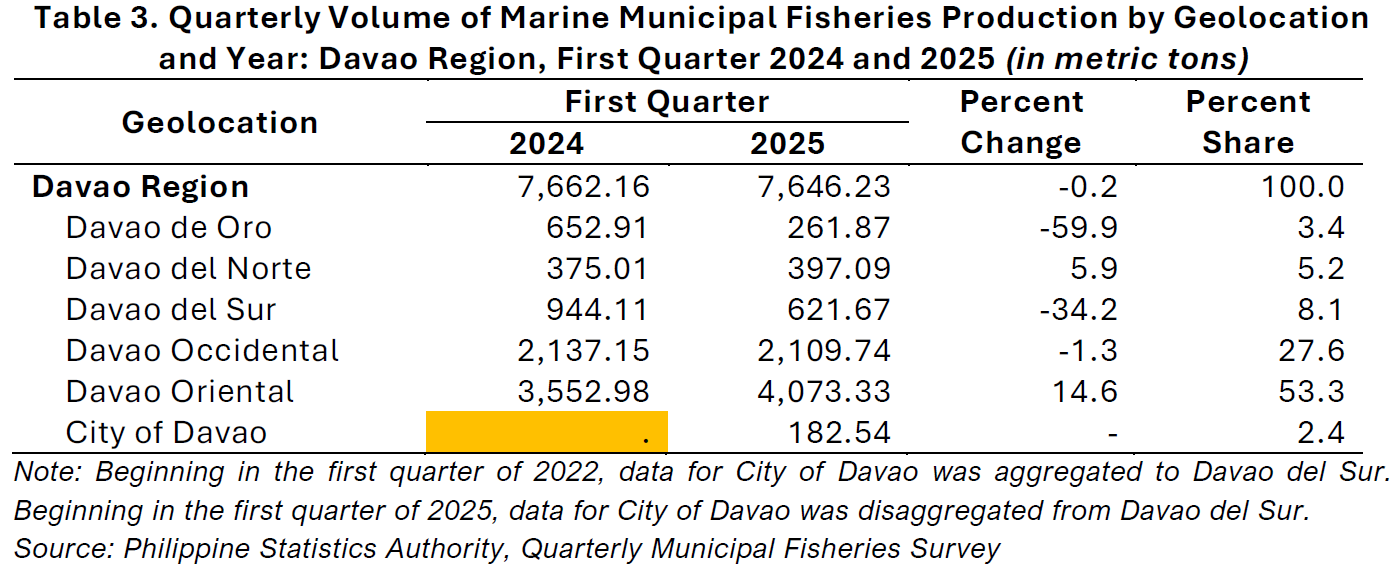
In terms of percentage share to the regional total, Davao Oriental dominated marine municipal fisheries production with 53.3 percent, indicating it as the primary source of catch in the region. Davao Occidental followed with a 27.6 percent share. Davao del Sur contributed 8.1 percent, while Davao del Norte and Davao de Oro accounted for 5.2 percent and 3.4 percent, respectively. The City of Davao made up 2.4 percent of the total. These figures reveal a significant concentration of production in Davao Oriental and Davao Occidental, which together supplied more than 80.0 percent of the region’s marine municipal fisheries output in the first quarter of 2025.
D. Volume of Inland Fisheries Production
Inland fisheries cover fishing operations performed in inland bodies of water using fishing vessels of three gross tons or less, or fishing not requiring the use of fishing vessels.
In the first quarter of 2025, inland fisheries production in the Davao Region totaled 3.88 metric tons, marking a 36.8 percent decrease from the 6.14 metric tons recorded during the same period in 2024. This sharp decline reflects a downturn in inland fishing activities across most parts of the region, with only one province reporting growth during the period.
All provinces experienced a decline in inland fisheries production except Davao Oriental. Davao de Oro remained the top producer with 1.83 metric tons during the quarter. Davao del Norte followed with 1.21 metric tons and Davao Oriental with 0.68 metric tons. Davao del Sur, the City of Davao, and Davao Occidental had 0.08 metric tons, 0.05 metric tons, and 0.02 metric tons of production, respectively (Table 4).

In terms of contribution to the total inland fisheries production in 2025, Davao de Oro accounted for the largest share at 47.2 percent, maintaining its lead despite the decrease in volume. Davao del Norte followed with 31.2 percent, while Davao Oriental contributed 17.5 percent. The shares of Davao del Sur, Davao Occidental, and the City of Davao were minimal, at 2.1 percent, 0.5 percent, and 1.3 percent, respectively. These figures reveal a highly concentrated inland fisheries sector, primarily dependent on the production from Davao de Oro and Davao del Norte.
E. Volume of Aquaculture Production
Aquaculture involves the propagation and culturing of fish and other fishery species in farming facilities such as fishponds, fish pens, and fish cages. It also includes oysters, mussel, and seaweed culture.
In the first quarter of 2025, Davao Region recorded a total aquaculture production of 6,154.73 metric tons, representing a 26.2 percent increase from the 4,877.36 metric tons produced during the same quarter in 2024. This growth reflects a notable expansion in aquaculture activities across most of the region’s provinces and HUC.
At the provincial and HUC level, production trends varied. Davao del Sur’s is the top producer in aquaculture during the quarter, although its production declined by 9.0 percent, from 3,466.09 to 3,153.13 metric tons. Davao de Oro saw a significant increase of 50.6 percent, rising from 472.08 to 711.13 metric tons, while Davao del Norte recorded an even stronger growth of 69.7 percent, reaching 675.46 metric tons from 398.14 the previous year. Davao Oriental posted the most impressive surge, growing by 339.3 percent from 81.74 to 359.08 metric tons. Meanwhile, Davao Occidental experienced a slight decline of 7.8 percent, with production falling to 423.39 metric tons. The City of Davao added a substantial 832.54 metric tons to the regional total (Table 5).
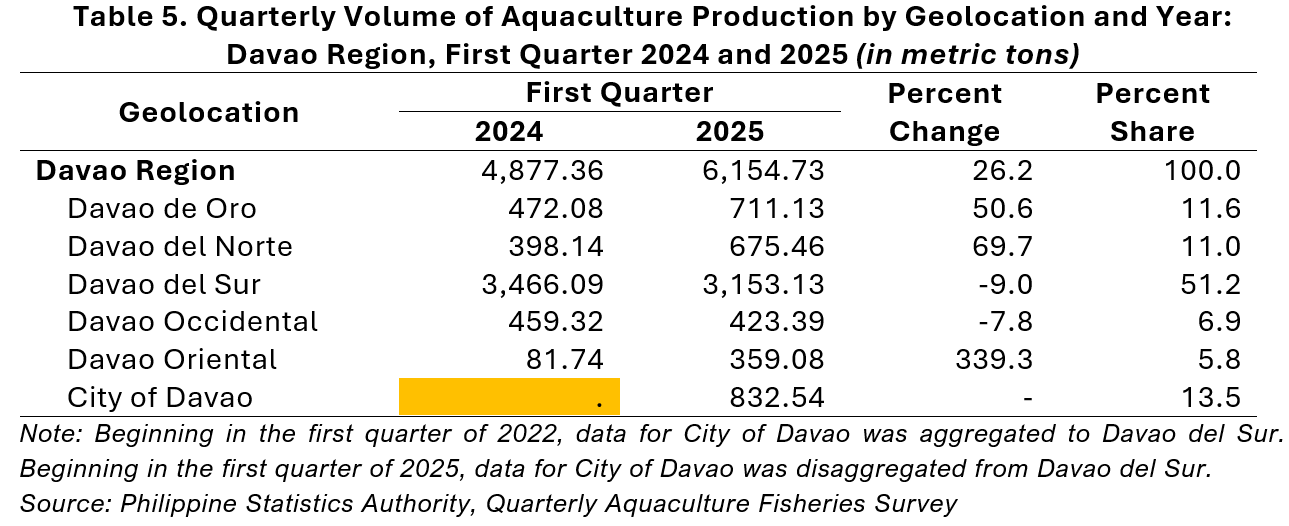
In terms of share to the total regional aquaculture production in 2025, Davao del Sur still held the largest portion at 51.2 percent, despite its year-on-year decline. The City of Davao followed with a significant 13.5 percent share. Davao de Oro and Davao del Norte contributed 11.6 percent and 11.0 percent, respectively. Davao Occidental made up
6.9 percent, while Davao Oriental, despite its massive percentage increase, comprised 5.8 percent of the total.
F. Top 10 Species by Volume of Production
In the first quarter of 2025, milkfish firmly held its position as the top species in terms of production volume, increasing from 3,418.21 metric tons in 2024 to 4,172.90 metric tons. Big-eyed scad rose sharply to the second spot in 2025, climbing from third place in 2024. Its production volume more than doubled, from 1,131.51 metric tons to 2,604.30 metric tons, making it the biggest climber among the top species. Squid, which previously held the second rank in 2024 with 2,009.50 metric tons, slipped to third place in 2025 despite an increase in production to 1,530.43 metric tons. Skipjack remained in the fourth spot with increased production from 857.62 to 1,146.40 metric tons. Meanwhile, the production of Penaeus vannamei (whiteleg shrimp) slightly decreased from 737.65 to 723.47 metric tons, maintaining its spot in the top five (Figure 1).
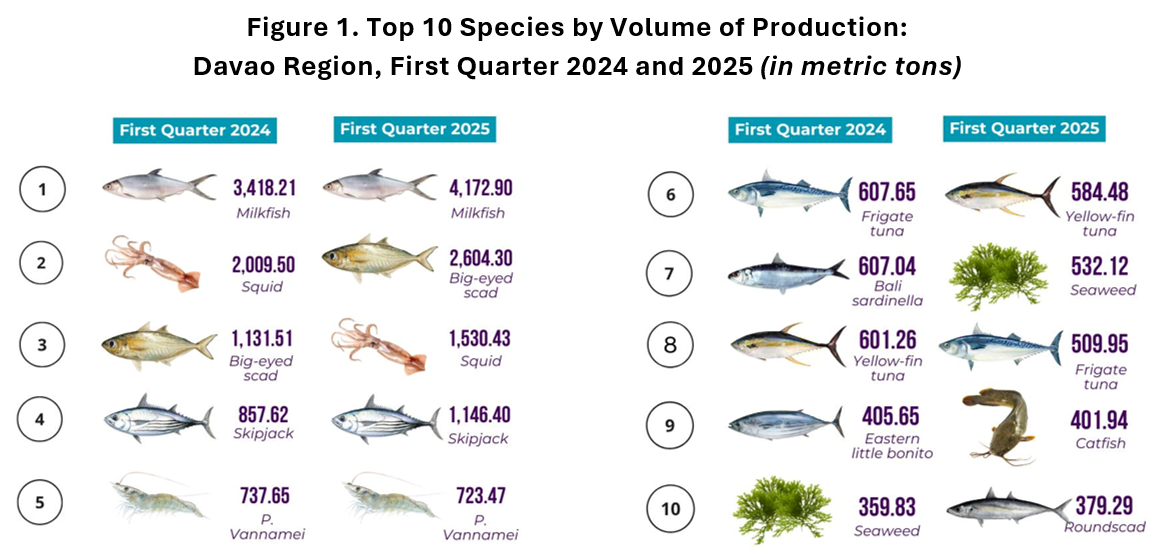
Yellow-fin tuna improved in rank from eighth in 2024 to sixth in 2025, even as its volume slightly decreased from 601.26 to 584.48 metric tons, indicating other species dropped more significantly in volume or ranking. Seaweed made a significant leap, jumping from tenth place in 2024 (359.83 metric tons) to seventh in 2025 with a notable increase to 532.12 metric tons. Frigate tuna, previously ranked sixth, dropped to eighth in 2025, with its volume declining from 607.65 to 509.95 metric tons. Catfish entered the top 10 occupying ninth place in 2025, with a volume of 401.94 metric tons, replacing previously ranked species such as Eastern little bonito or Bali sardinella. Finally, roundscad also joined the rankings at tenth place in 2025 with 379.29 metric tons, another new entrant that displaced earlier species in the lower tier of the list.
APPROVED FOR RELEASE:
RANDOLPH ANTHONY B. GALES
(Chief Statistical Specialist)
Officer-in-Charge
Regional Statistical Services Office XI
